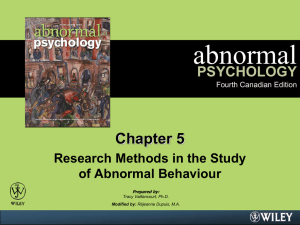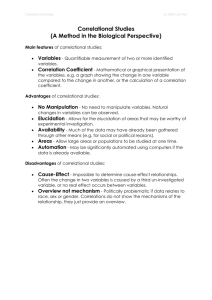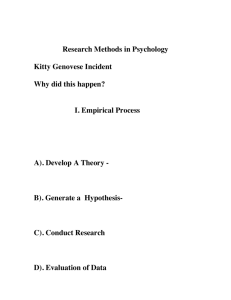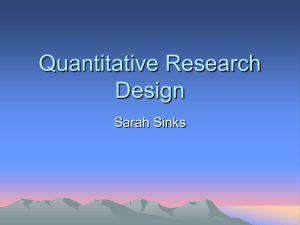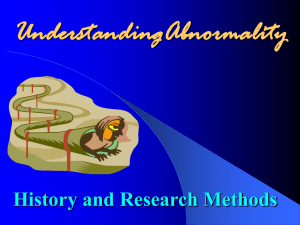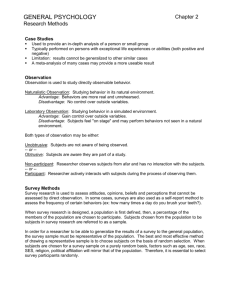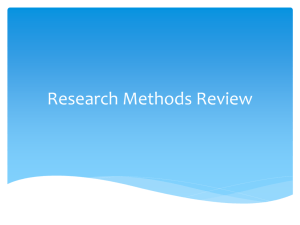abnormal PSYCHOLOGY Third Canadian Edition
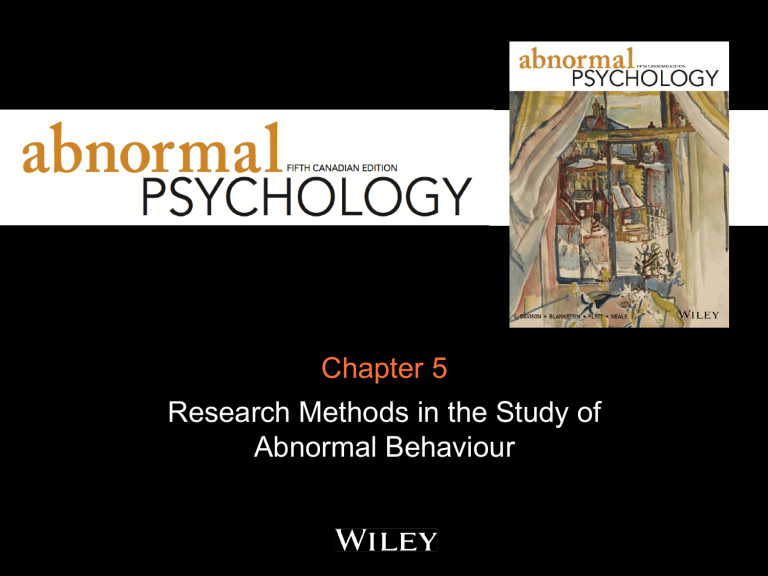
Chapter 5
Research Methods in the Study of
Abnormal Behaviour
Chapter Outline
•
Science and Scientific Method
•
Testability and Replicability
•
The Role of Theory
•
Research Methods
•
The Case Study
•
Qualitative Research
•
Epidemiological Research
•
The Correlational Method
•
The Experiment
•
Single-Subject Experimental Research
•
Mixed Designs
•
Meta-analysis
Science and Scientific Methods
•
Science: The pursuit of systematized knowledge through observation
•
Latin scire – means “to know”
•
Testability and Replicability
•
A hypothesis must be amenable to systematic testing that could show it to be false
•
What is observed must be replicable
• it must occur under prescribed circumstances not once, but repeatedly.
Science and Scientific Methods
•
Theory:
• a set of propositions meant to explain a class of phenomena.
•
The Role of Theory
•
Primary goal of science is to advance theories to account for data, often by proposing cause –effect relationships
•
Hypothesis
•
Expectations about what should occur if a theory is true
How does theory get generated?
•
The generation of a theory is perhaps the most challenging part of the scientific enterprise.
•
Consider data that have been previously collected and then decide that a given way of thinking about the data is the most economical and useful.
•
Sometimes creativity is employed (insight)
How do we judge a theory?
•
What criteria are applied in judging the legitimacy of a theoretical concept?
•
Operationism
• each concept take as its meaning a single observable and measurable operation.
•
Each theoretical concept would be nothing more than one particular measurable event.
•
However - if each theoretical concept is operationalized in only one way, its generality is lost.
•
The need for multiple measures that tap into different facets of a concept
Research Methods: Case Study
•
The detailed study of one individual, based on a paradigm
•
Providing detailed descriptions
•
Collecting historical and biographical information
•
Often includes details of therapy sessions
•
Several case studies can be compared and analyzed for common elements through a specific method
•
The case study as evidence
•
Particularly useful to negate a universal theory or law
•
Not useful to rule out alternative hypotheses
•
Generating hypothesis
•
Exposure to a large number of cases may allow the clinician to notice similarities of circumstances and outcomes
Theory-Building Case
Studies
•
Refers to the notion that an adequate theory must be able to account for commonalities across case studies as well as the distinct and unique elements of a particular case.
The Rise Of Qualitative Research
•
There has been a proliferation of qualitative research in psychology
•
Qualitative research is similar to case study research in that the focus is on the unique and rich experiences of a small group of people who are studied in depth.
•
Descriptive accounts with a subjective, idiographic emphasis are the focus rather than quantitative research
The Rise Of Qualitative Research
•
Qualitative research is subject to some of the same criticisms that apply to case study accounts
•
However, well-done qualitative research can illuminate important phenomena that really seem to reflect issues and themes that matter to people and are central to understanding them.
Research Methods: Epidemiological Research
•
Epidemiology : Study of frequency and distribution of a disorder in a population
•
Data are gathered about the rates of a disorder and its possible correlates in a large sample or population
•
Provides a general picture of a disorder
•
Focuses on determining three features of a disorder:
•
1. Prevalence : Proportion of a population that has the disorder at a given point or period of time
•
2. Incidence : the number of new cases of the disorder that occur in some period, usually a year
•
3. Risk factors : Conditions or variables that, if present, increases the likelihood of developing the disorder
• knowledge about risk factors can give clues to the causes of disorders.
Research Methods (cont.)
•
Correlational Method
•
Is there a relationship between or among two or more variables?
•
Measuring Correlation
•
Correlation coefficient ( r )
•
May take any value between +1.00 and -1.00
•
Measures magnitude and direction of relationship
•
Statistical Significance
•
Likelihood results of an investigation are due to chance
•
Often set in psychology at p = .05
Statistical Significance
•
As the size of the correlation coefficient increases, the result is more and more likely to be statistically significant.
•
The greater the number of observations, the smaller r (the correlation) needs to be to reach statistical significance.
Applications of Correlation to
Psychopathology
•
Whenever we compare people given one diagnosis with those given another or with people without a psychological diagnosis, the study is correlational.
•
Often investigations in abnormal psychology are not recognized as correlational, perhaps because participants come to a laboratory for testing.
•
Classificatory variables
•
Variables that are already present and are simply measured by the researcher (i.e., disordered or not disordered, age, sex, social class, etc.).
Research Methods (cont.)
•
Correlational Method cont.
•
Problems of Causality
•
Critical drawback of correlational research
•
Does not allow determination of cause-effect relationships
•
Correlation between two variables tells us only that they are related or tend to co-vary with each
•
Directionality problem
•
How can we tell which is the cause and which is the effect?
•
Correlation does not imply causation
•
Prospective, longitudinal design helps resolve the directionality issue
•
High-risk method: individuals with a predisposition are studied
•
Third-variable problem
Longitudinal modelling and group trajectories
•
Developmental trajectories
• the levels of a particular behaviour over time
•
Group-based trajectory
• is based on evidence that it is impossible to distinguish clear subgroups of participants in a sample and it is important to distinguish these groups both when considering the contribution of developmental factors and the best treatment options for these people (Nagin & Odgers, 2010).
Longitudinal modelling and group trajectories
•
Groups are identified through latent class growth analysis
•
Multivariate statistical techniques are used to establish growth curves.
•
Researchers using this approach can examine predictors of class membership as well as predictors of growth within a particular class.
Research Methods (cont.)
•
Experimental Design
•
Generally considered most powerful tool for determining causal relationships between events
•
Involves (1) random assignment of participants to different conditions (2) manipulation of IV and measurement of DV
•
In the field of psychopathology, the experiment is most often used to evaluate the effects of therapies.
•
Basic Features of Experimental Design
•
1. Researcher typically begins with an experimental hypothesis
•
2. Investigator chooses an independent variable (IV) that can be manipulated
•
3. Participants are assigned to the two conditions by random assignment
•
4. Researcher arranges for the measurement of a dependent variable (DV)
•
5. Produces an experimental effect
Research Methods (cont.)
•
Experimental Design cont.
•
Internal validity
•
Extent to which effect can be confidently attributed to manipulation of IV; Inclusion of at least one control group
•
Confounders
•
Internally invalid studies
•
Placebo Effect
• an improvement in a physical or psychological condition that is attributable to a client ’s expectations of help rather than to any specific active ingredient in a treatment.
•
Placebo control group; Double-blind procedures (when neither the researchers nor the clients are aware of who has been placed in the treatment and placebo control groups)
•
External validity
•
Can the results be generalized beyond immediate study?
•
Analogue experiments
•
The use of a related phenomenon (an analogue) in the lab
• behaviour is rendered temporarily abnormal through experimental manipulations.
•
Randomized Controlled Trials (RTC)
Significance in Experiments
•
Between-group variance
•
The difference between groups
•
The experimental effect
•
Within-group variance
•
The difference within the groups
•
Statistical significance is tested by dividing the between group variance by a measure of the within-group variance.
•
When the average difference between the two groups is large relative to the within- group variance, the result is more likely to be statistically significant.
Research Methods (cont.)
•
Single-Subject Experimental Designs
•
Participants are studied one at a time and experience a manipulated variable
•
Reversal design or ABAB design
•
Measurement of a specific behaviour at different times:
•
(1) During an initial time period, the baseline (A)
•
(2) During a period when treatment is introduced (B)
•
(3) During a reinstatement of the condition that prevailed in the baseline period (A)
•
(4) During the re-introduction of the experimental manipulation (B)
•
The ABAB design is most appropriate when it is assumed that the effects of manipulations are temporary
Research Methods (cont.)
•
Mixed Designs
•
The combination of experimental and correlational designs
•
Classificatory or correlational variables (e.g., having PTSD or not) are not manipulated nor created by the researcher
•
Experiments demand the manipulation of a variable (e.g., three types of treatment for major depression)
Research Methods (cont.)
•
Meta-Analysis
•
The review of several studies in order to determine the effects of treatment, using a statistic called effect size
•
Meta-analysis can hardly provide definite answers b/c:
•
1. It is a complicated process that requires decisions at each of numerous phases or steps
•
2. Results of a meta-analysis are difficult to interpret
•
The combination of multiple meta-analyses is called meta-metaanalysis
•
Despite difficulties and shortcomings, meta-analyses have been useful
Meta-analysis
•
Moderator variables
–
other factors such as gender that may influence or qualify the results in some meaningful way
Copyright
•
Copyright © 2014 John Wiley & Sons Canada, Ltd.
All rights reserved.
Reproduction or translation of this work beyond that permitted by Access Copyright (The Canadian Copyright Licensing
Agency) is unlawful.
Requests for further information should be addressed to the Permissions Department, John Wiley & Sons
Canada, Ltd. The purchaser may make back-up copies for his or her own use only and not for distribution or resale. The author and the publisher assume no responsibility for errors, omissions, or damages caused by the use of these programs or from the use of the information contained herein.
